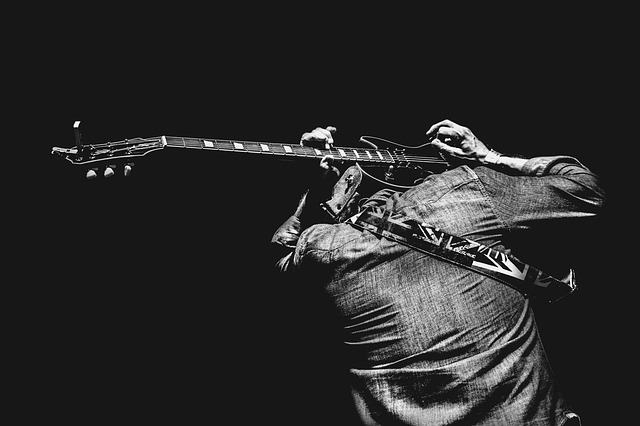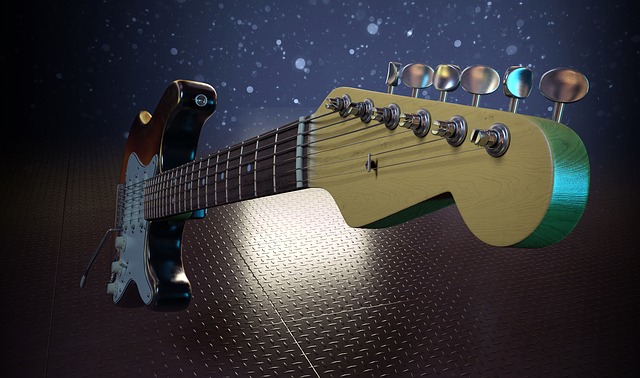It Is Important to Memorize the Guitar Notes

Everything you need to know about a scale, a chord, or a musical relationship is going to revolve around “the note”. Knowing every note on the guitar neck is the starting point to becoming an intermediate guitar player. In other words, the guitar notes could be considered the musical alphabet for the guitarist to then structure into a phrase or expression. You should memorize notes.
I don’t know of any great guitar player that either plays by ear, or a combination of ear and knowledge, where they have absolutely no clue of what note they are playing. At some point in their playing and learning process, whether self taught or schooled, they have associated with the fact that an “A” note is an “A” note; a “B”note is a “B” note and so on.
Let’s say that you are at a jam session, and someone says that we are going to do a groove in G. Wouldn’t it be nice to look at your neck and be able to visualize all of the G notes. Consequently, you would be able to bounce around all over your guitar neck. Since you have the tonal center in your ear, you would know what that G note on the first string 15th fret is going to sound like before you drill it. Yeah buddy….that feels good!
What Are The Guitar Notes
There are 12 notes in a sequence. In other words, one note follows another until you have made it through all 12. Once you have made it through the 12 note sequence, then the entire sequence can be repeated in the next octave higher:
A, A#, B, C, C#, D, D#, E, F, F#, G, G# then the next octave A, A#, B, C, C#, D, D#, E, F, F#, G, G#
and so on until you have made it to the end of your neck.
The # sign indicates a sharp. A sharp means to raise a note up a half step.
Some of the notes can have two different names depending on how they are used, or in what key center they are used in.
All of the sharps (#’s) in the above sequence, can also have another name. Hence, one pitch can have two different names. In the ascending sequence listed above, we used sharps to move a note up a half step.
If we were to list that same sequence of notes in a descending sequence, we would most likely use flats (b’s) to indicate that the note is one half step lower.
Ab, G, Gb, F, E, Eb, D, Db, C, B, Bb, A, Ab
So, notes that can have two different names, Ab = G#; Gb = F#; Db = C#; Bb = A#
Also interesting, if you look at either sequence, you notice that there is no sharp or flat between the B note and C note, and there is also no flat or sharp between the E note and the F note. This means that the B# = C, and the Cb = B. Similarly, the E# = F, and the Fb = E.

What is a Half Step
A half step is the distance of moving one fret to the next on the same string. Or rather, moving to the next adjacent note

How Many Notes Are There on The guitar
The guitar is an interesting instrument in the sense that on a guitar, you can play the same note in several different places. A piano is not like that. On the piano, each key represents a single note that can only be sounded by that one piano key.
Therefore, the question of how many notes are there on the guitar is double edged. It could be two different questions. The first question being, “How many places are there on a guitar that can sound a note,” and the second question might be “How many different pitches can be sounded on the guitar?”
Guitars also have a different number of frets depending on the brand, model, and style of the guitar. Electric guitars often have 24 frets, acoustic electric guitars often have 22 frets, and many acoustic guitars will only have 20 frets. Consequently, doing the math: 24 frets X 6 strings = 144 places to sound a note even though some of the pitches would be duplicated. 22 frets X 6 strings = 132 places to sound a note. 20 frets X 6 strings = 120 places to sound a note.
How Many Octaves are there on the Guitar
The lowest note on the guitar, when it is in standard tuning, is an E note which is two octaves below a middle C. (Middle C on a guitar is the note played on the 2nd string at the 1st fret)
The highest note on a 24 fret guitar is also an E note. That E note is 2 octaves above the middle C. So, there are 4 octaves on a guitar if the guitar has 24 frets.

Do I Really Need To Memorize All of the Notes on the Fretboard ?
The short answer is : Yes. The only exception that I can think of is if you have an exceptionally well trained ear, and your situation makes it not important for you to communicate to other musicians what you are playing. In other words, you play and everybody else will need to figure it out on their own and follow along.
Knowing where you are and what note you are playing, in my opinion, is the turning point between being an intermediate player and moving toward becoming an advanced player.
If you are playing a groove in E, then it’s good idea to know where all of the “E” notes are on your guitar. The whole groove is centered around that solid core tone.
Memorize Notes on Your Guitar Neck. 10 useful tips
Tip #1: Play and say the chromatic sequence of notes on each string.
Start on the 6th string. Play the 6th string open and say “E”
Next, play the 1st great on the 6th string and say “F”
…….and so on through the entire sequence, and up the entire string
E F F# G G# A A# B C C# D D# E F F# G etc
*Notice that on some of the frets, the same note can have two different names
Do this same exercise on each string……so
Play the 5th string open and say “A”
Play the 5the string 1st fret and say “A#” (and so forth)

Tip #2: Play and say the chromatic sequence in reverse
(24 fret guitar example)
Start on the 6th string at the 24th fret. Play that note and say “E”
Move down to the 23rd great on the 6th string. Play that note and say “Eb”
*Do this same exercise on each string
Tip #3: Play all of the “A” notes that are below the 12th fret.
Set a timer for 30 seconds. Over and over again, run through all of the “A” notes that occur below the 12th fret until the timer goes off.
1st sting 5th fret
2nd string 10th fret
3rd string 2nd fret
4th string 7th fret
5th string open
6th string 5th fret
Do this same exercise with all of the unaltered notes: A B C D E F G
Tip #4: Play through all of the “A” notes which occur above the 12th fret
Similar to the previous exercise, set the timer for 30 seconds. Over and over again, play through all of the “A” notes which occur above the 12th fret.
1st string 17th fret
2nd string 22nd fret
3rd string 14th fret
4th string 19th fret
5th string 24th fret
6th string 17th fret
Do this same exercise for all of the unaltered notes: A B C D E F G
Tip #5: In sequence, play the unaltered notes on each string.
For example, on the 6th string play E F G A B C D E F G A B C D E
E note 6th string open
F note 6th string 1st fret
G note 6th string 3rd fret
A note 6th string 5th fret
B note 6th string 7th fret
C note 6th string 8th fret
D note 6th string 10th fret
E note 6th string 12th fret
F note 6th string 13th fret
G note 6th string 15th fret
A note 6th string 17th fret
B note 6th string 19th fret
C note 6th string 20th fret
D note 6th string 22nd fret
E note 6th string 24th fret
Do this same exercise on each string
Tip #6: Play all of the major chords in the open position and name the individual notes of each chord.
Tip #7: Play and say all of the notes at each fret
Start by doing all of the odd numbered frets. So, playing all of the notes at the first fret beginning with the 6th string first fret, and then the 5th string fist fret, and so on
6th string first fret play and say F
5th string 1st fret play and say Bb
4th string 1st fret play and say Eb
3rd string 1st fret play and say Ab
2nd string 1st fret play and say C
1st string 1st fret play and say F
Next, do the same exercise on the 3rd fret, then the 5th fret, then the 7th fret, and the rest of the odd numbered frets.
Tip #8: Play and say the name of each note in every scale you know.
Tip #9: Play and say the notes as they occur diagonally across your guitar neck.
1st string first fret, 2nd string second fret, 3rd string third fret, 4th string fourth fret, 5th string fifth fret, and 6th string sixth fret. Challenge yourself by shifting the same pattern up and down the neck and/or by widening the interval between each note.
Tip #10: Play and say every note in a whole step sequence.
In this exercise, you would play and say every other note.
Start on any note and then advance up or down the string in whole step intervals while playing and saying each note.
Example:
5th string 3rd fret play and say C
5th string 5th fret play and say D
5th string 7th fret play and say E
5th string 9th fret play and say F#
5th string 11th fret play and say G#
5th string 13th fret play and say A#
…..and so on
JSIG Shop: https://www.JSIGuitar.net
